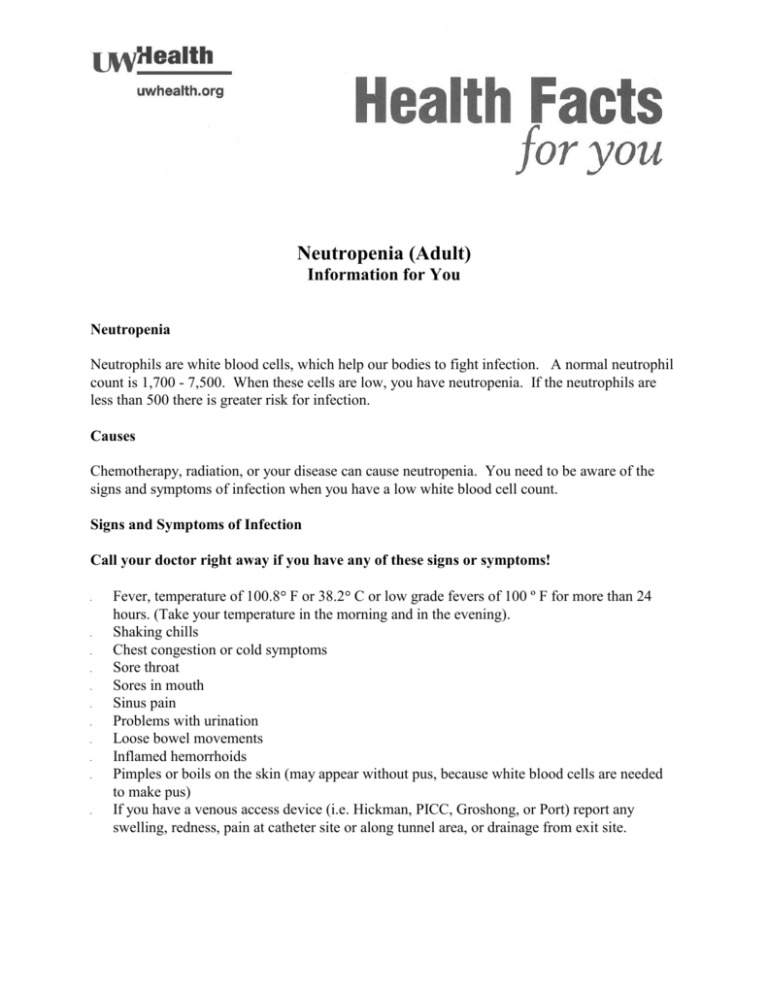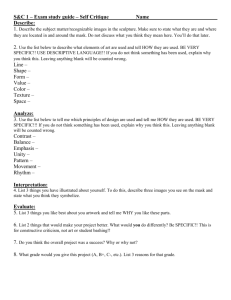
Neutropenia (Adult)
Information for You
Neutropenia
Neutrophils are white blood cells, which help our bodies to fight infection. A normal neutrophil
count is 1,700 - 7,500. When these cells are low, you have neutropenia. If the neutrophils are
less than 500 there is greater risk for infection.
Causes
Chemotherapy, radiation, or your disease can cause neutropenia. You need to be aware of the
signs and symptoms of infection when you have a low white blood cell count.
Signs and Symptoms of Infection
Call your doctor right away if you have any of these signs or symptoms!
Fever, temperature of 100.8 F or 38.2 C or low grade fevers of 100 º F for more than 24
hours. (Take your temperature in the morning and in the evening).
Shaking chills
Chest congestion or cold symptoms
Sore throat
Sores in mouth
Sinus pain
Problems with urination
Loose bowel movements
Inflamed hemorrhoids
Pimples or boils on the skin (may appear without pus, because white blood cells are needed
to make pus)
If you have a venous access device (i.e. Hickman, PICC, Groshong, or Port) report any
swelling, redness, pain at catheter site or along tunnel area, or drainage from exit site.
What to Do
Wash your hands often, before making meals, eating, and after using the bathroom. This
is the best way to prevent infection.
Perform mouth care often with a soft toothbrush. If you wear dentures, clean twice a day.
Keep your skin dry and clean, under your arms, groin, and rectal areas.
Do not eat foods that may contain bacteria. Avoid unwashed raw fruit or vegetables.
Avoid salad bars. See HFFY #5235 for Healthy Eating With Low White Counts
Avoid people who are ill with colds, flu, and chicken pox.
Avoid large crowds, such as at shopping malls.
Do not smoke and avoid people who do smoke.
Do not put anything in your rectum before checking with your doctor.
Avoid cleaning birdcages, fish tanks, or cat litter boxes.
At certain times you may need to wear a mask, (see below).
When to wear your mask
If you are in the hospital and have neutropenia or are less than 100 days post-transplant, you must
wear a mask when you are out of your room. You must also wear it when you come to the clinic.
If you are in a public place, (church, mall, sports event, etc.) you should wear a mask.
What type of mask to wear
Kimberly Clark PCM 2000 filtration mask (If this mask is too large, then a smaller sized
mask, N-95 should be worn).
How to wear the mask
The upper and lower edges of the mask are snug to your face.
The elastic bands are placed so that one is on the base of the skull and the other is near
the top of your head (see picture below).
The nose -piece must be pinched down to snugly fit the bridge of your nose.
There should not be gaps between the mask and your face.
2
Your nurse will help fit your mask and give you a supply for at home. You can purchase more
masks from your local drug store.
Masks may be reused. Store in a clean dry place. Change your mask if:
It is moist or will not keep its shape.
You wear it for more than a total of 8 hours
How Infections Are Treated
Oral or IV antibiotics may be given.
Sexual Guidelines
Contact your doctor or nurse with questions on when to resume sexual activity.
Do not have more than one sex partner.
Do not have anal intercourse.
Do not use an intrauterine device for birth control.
Use a condom.
Phone Numbers
Dr.
at
may be reached from
or feel welcome to call
a.m. to
p.m.
.
The Spanish version of this Health Facts for You is #6248.
Your health care team may have given you this information as part of your care. If so, please use it and call if you
have any questions. If this information was not given to you as part of your care, please check with your doctor. This
is not medical advice. This is not to be used for diagnosis or treatment of any medical condition. Because each
person’s health needs are different, you should talk with your doctor or others on your health care team when using
this information. If you have an emergency, please call 911. Copyright © 4/2014 University of Wisconsin Hospitals
and Clinics Authority. All rights reserved. Produced by the Department of Nursing. HF#4577
3









